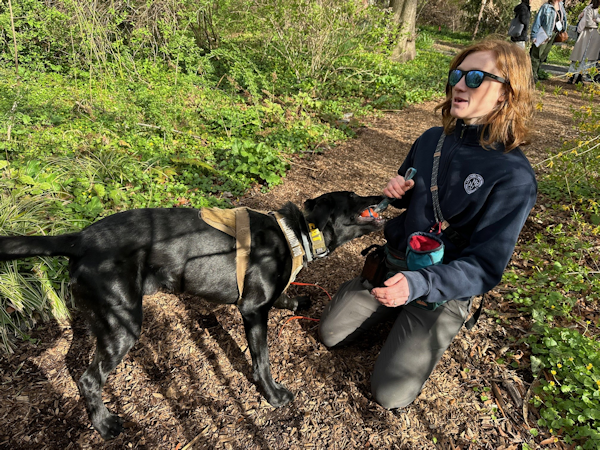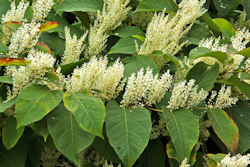SEJournal Online is the digital news magazine of the Society of Environmental Journalists. Learn more about SEJournal Online, including submission, subscription and advertising information.
 |
 |
| The detection dog Peat, above with his handler, Arden Blumenthal, is a black American Field Labrador trained as a conservation canine, skilled in sniffing out invasive plant species. Photo: NF Castaldo. |
Feature: Sniffing Out Invasive Plant Species — Conservation Canines in Action
By Nancy Castaldo
Invasive plant species are thriving across the globe. Many compete with native organisms for nutrients, light, space and water resources, causing a reduction of biodiversity and a host of other environmental problems. The planet’s warming temperatures are exacerbating their expansion.
Removing invasive species is challenging enough in small, contained gardens, but can be nearly impossible in large wilderness spaces.
One of the challenges is simply finding the plants. A fairly recent tool to aid in their detection is the use of a subset of detection dogs known as conservation canines.
Conservation canines have
become a valuable tool for
conservation scientists conducting
population studies of plants and animals.
Like all detection dogs, conservation canines are trained to use their noses to locate a desired subject. They have become a valuable tool for conservation scientists conducting population studies of plants and animals.
During the 2024 Society of Environmental Journalists conference, roughly three dozen attendees got to see one of these dogs in action in the James G. Kaskey Memorial Park at the University of Pennsylvania.
The stars of this demonstration were a small, black American Field Labrador named Peat and his handler, Arden Blumenthal, the coordinator for the New York-New Jersey Trail Conference Conservation Dogs Program.
Aggressive aliens in UPenn park
Kaskey Park, established as a botanical garden in the late 1800s by a UPenn doctor, is tucked away on the campus, behind the zoology building.
 |
| Japanese knotweed is an invasive plant that conservation detection dogs are currently being used to help sniff out on construction sites in Ireland. Photo: U.S. National Park Service (CC BY-NC-SA 2.0). |
Among the 450 plants and mature trees, including a rare American elm, are a number of invasive species.
“Anywhere that you gaze into the distance in this park and see a yellow flower on a lovely low ground cover with kind of waxy, shiny leaves — that is Ficaria verna, lesser celandine,” said UPenn horticulturist and Kaskey Garden supervisor Claire Thurston-Emmert. “It is choking out much of the park this season. It is an aggressive spreader.”
A five-year plan is in place to attempt its eradication, but the plant’s waxy leaves and little bulblets make removal difficult and dispersal easy. The bulblets can hide in the roots of another plant that is being moved or gifted to another gardener. They can also get caught in shoe treads and find their way to other locations.
Japanese knotweed is another invasive plant found in the park that is an aggressive spreader and equally tough to eradicate.
Conservation detection dogs like Blumenthal’s Peat are currently being used to help sniff out knotweed on construction sites in Ireland. Their sense of smell is so sharp they can even detect rhizomes that haven’t yet broken the soil’s surface.
Following invisible scent trails
While Thurston-Emmert discussed the park’s invasive species, Blumenthal hid three rare orchid samples along the garden paths for Peat to locate with his super smelling skills.
Before sending him through the park, Blumenthal warmed Peat up off-leash with a kibble treat to get him moving. He moved over and under her legs, stretching his body.
If they had been in a wild setting, Blumenthal would then have let Peat search for his targets without his leash, but in the university park amid all the observers for the demonstration, she kept hold of his long leash.
With his nose sometimes to the ground and sometimes in the air, Peat pulled her through the paths as he picked up the scent trail of the hidden samples.
All detection dogs give an alert when they locate their target. Some bark. Others sit. When Peat found the three samples — within 10 minutes or so — he demonstrated his freeze and stare alert. Blumenthal rewarded him with a game of tug with his toy.
Finding invaders before they dig in
Peat’s specialized nose is trained to enable him to detect small or cryptic invasive plant species that are difficult to find with human senses alone.
Since 2019, Peat has joined the conservation dogs of the NY-NJ Trail Conference to find unknown infested sites, map out where infestations of plants like Scotch broom may be spreading and detect hard-to-find individuals that could lead to persisting infestations.
The organization now takes on more conservation and stewardship roles, including the management of invasive species growing in and around the trails.
The team doesn’t go after the removal of all the invasive species, since some are often entrenched in an area.
Scotch broom, however, is considered an emerging, or Tier 2, species, which has the potential for total eradication. “It means that they have either arrived relatively recently or are geographically still contained,” explained Blumenthal.
If Peat and his canine colleagues
are successful, the team can help
prevent the spread of Scotch broom
throughout their region.
If Peat and his canine colleagues are successful, the team can help prevent its spread throughout their region.
Dogged workers get results
Sniffer dogs are valuable assets to the conservation programs for many reasons.
According to Blumenthal, the conservation detection dog methodology is best used for finding targets that are rare, small and sparsely distributed.
The dogs also excel in projects with difficult terrain, she said. And while humans might keep going back to the same sites, “dogs just follow their noses, wherever that leads them.”
The dogs are also always learning new scents. Peat already knows six.
He will even zero in on one of the scents in his scent library when he is on the trail for something else, as he did recently on an ongoing bobcat conservation survey project.
Blumenthal shared that he alerted for Scotch broom during the search for bobcat scat because he knew that the scent of the invasive plant also meant ball, which is synonymous with play. “It sure does mean ball, buddy. And I cried all the way home,” said Blumenthal, recalling her proud-parent moment of seeing their hard work pay off in the field.
Peat is just one dog among many working to help conservationists battle the ongoing spread of invasive plant and animal species around the world.
However, unlike many other organizations that contract sniffer dogs to assist them periodically or on a one-time basis, the Trail Conference’s unique program is based on having a small team of dogs and handlers that consistently focus on the Hudson Valley region and Conference properties.
“We have the pleasure, honor and privilege to work on some of these same projects year after year after year and really see results happen. We can think of the data holistically, without handing the data off to other people,” explained Blumenthal.
Adding conservation detection dogs to the Trail Conference’s Invasives Strike Force has demonstrated the usefulness of these dogs to locate unknown infested sites, detect difficult-to-find individual species and assist in establishing infestation borders.
As climate change and the spread of invasive species challenge our environment, these dogs are proving to be an important asset in the conservation toolbox.
[Editor’s Note: Material for this story was drawn from a mini-tour led by Castaldo and Maddy Lauria at the Society of Environmental Journalists’ annual conference in Philadelphia in April 2024, whose sponsors are listed here. Learn more about training detection dogs in this video tour of the PennVet Working Dog Center.]
Since Nancy Castaldo began her career as an intern at Audubon Magazine, she has written many articles. She has also become an author of nonfiction books for young readers, including “Sniffer Dogs: How Dogs (and Their Noses) Save The World.” Her young adult titles have earned the Green Earth Book Award, Sigurd F. Olson nature writing honors and JLG Gold Selections. She often writes about food and water security. Her most recent title, “The World That Feeds Us,” published by Slow Food Editore in Italy and Quarto in the U.K. and U.S., is a finalist for Italy’s Premio Demetra environmental literature award. She is currently at work on a book for adult readers for Island Press.
* From the weekly news magazine SEJournal Online, Vol. 9, No. 28. Content from each new issue of SEJournal Online is available to the public via the SEJournal Online main page. Subscribe to the e-newsletter here. And see past issues of the SEJournal archived here.












 Advertisement
Advertisement 



